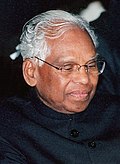 |
|---|
- Top left: Sarvepalli Radhakrishnan was the first and longest-serving vice president of India.
- Top right: V. V. Giri was the first vice president to serve as acting president upon the demise of the president.
- Bottom left: Mohammad Hamid Ansari was the second-longest-serving vice president and the only vice president to serve under three presidents.
- Bottom right: C. P. Radhakrishnan is the current vice president.
The vice president of India is the second highest constitutional office in the government of India after the president. In accordance with Article 63 of the Constitution of India, the vice president discharges the functions of the president when a contingency arises due to the resignation, removal, death, impeachment or the inability of the president to discharge their functions. They are also the ex officio chairperson of the Rajya Sabha, the upper house of the Parliament of India. [1] [2]
Contents
The vice president is elected by an electoral college consisting of all members of both houses of the Parliament in accordance with the system of proportional representation by means of the single transferable vote via a secret ballot conducted by the Election Commission of India. Once elected the vice president continues in office for a five-year term, but can continue in office irrespective of the expiry of the term, until a successor assumes office. [3] They can be removed by a resolution passed by an effective majority in the Rajya Sabha. [4] They are responsible for the protection of the rights and privileges of the members of the Council of States. They also decide whether a bill introduced in the Rajya Sabha is a financial bill. [1] There have been 15 vice presidents since the inception of the post in 1950. The first vice president of India, Sarvepalli Radhakrishnan, took oath at Rashtrapati Bhavan on 13 May 1952. [5] He later served as the president. [6] Following the death of Zakir Husain in 1969, Varahagiri Venkata Giri resigned from the post of vice president to contest the presidential election and got elected. [7] Out of 15 vice presidents, six of them later went on to become the president. [7] Krishan Kant has been the only one to die during his tenure. [8] Venkaiah Naidu [9] is the first vice president to be born after Indian Independence.

















